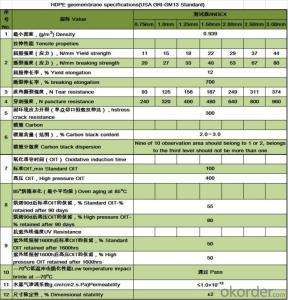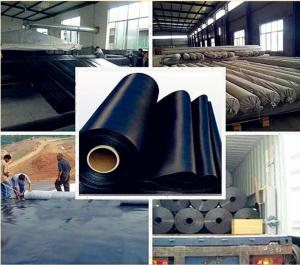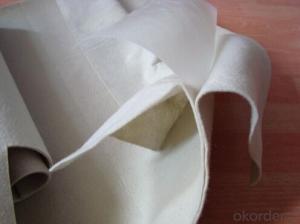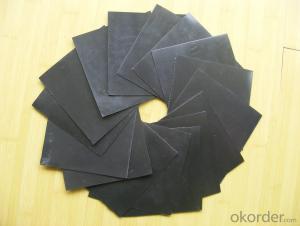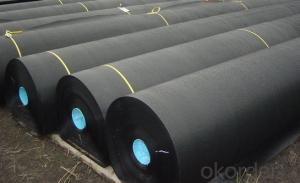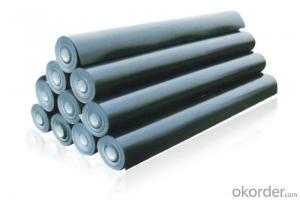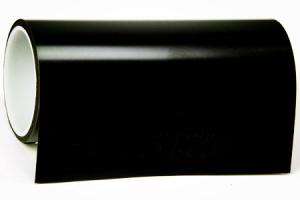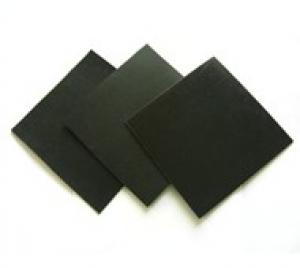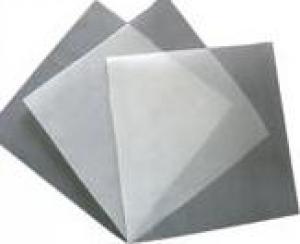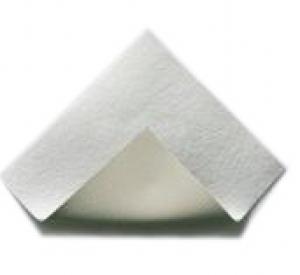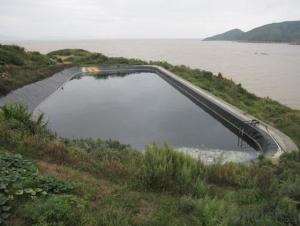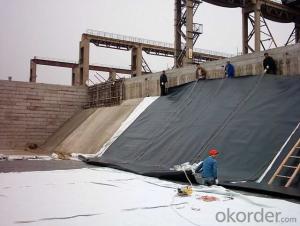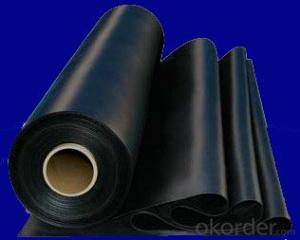Antiseepage material 0.5mm HDPE Geomembrane
- Loading Port:
- China Main Port
- Payment Terms:
- TT or LC
- Min Order Qty:
- -
- Supply Capability:
- -
OKorder Service Pledge
OKorder Financial Service
You Might Also Like
1.Product Description:
Our product was proved as good physical and mechanic performance, high tearing resistance, strong deformation adaptability, puncture, aging, ultra-violet radiation, oil and salt, alkali and corrosion resistance, high and low temperature resistance, non-toxicity, long operational life, good waterproof, drainage, anti-seepage and damp proof effects, complete width and thickness specifications, low cost and simple construction.And they are uesd in:
1.used in landfill caps
2. secondary containment for above ground tank farms,
3.as well as within various other containment structures such as dams, canals, ponds, rivers and lakes
4.They are also used for waterproofing of buildings and other similar structures.
2.Product Characteristic:
1) Environmental protection, sanitation (such as solid waste landfills, sewage treatment plants, power plants Chi-conditioning, industrial, hospital solid waste, etc.) .
2) Water (such as rivers, lakes and reservoirs of the anti-dam, plugging, reinforcement of the canal seepage, the vertical wall of the heart, slope protection, etc.).
3) Municipal Engineering (subway, on the ground floor of the building, planted roof, the roof garden of anti-seepage, sewage pipes lining, etc.).
4) Landscape (man-made lake, river, reservoir, golf courses reservoirs of the substrate, slope protection, green lawn of the waterproof moisture, etc.).
5), Petrochemical (chemical plants, oil refineries, gas storage tanks of the anti-chemical reaction tanks, sedimentation tanks of the lining, etc.).
3.Product Specifications:
1.thickness : 0.5mm,
2.width: Within 8 m ;
3.longth:50-100m(at request)
4.material: HDPE,( LDPE, LLDPE, PVC).
5.color: Black or as customer required
4.Reference Picture:
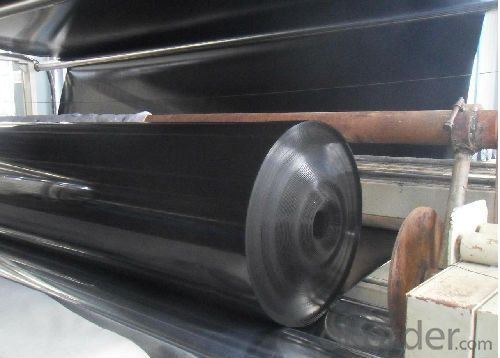
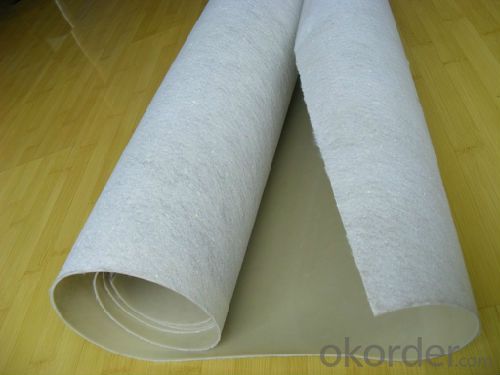

- Q:How about sticking membrane on the window?
- It is very good. The styles of the membrane are various, enough for you to choose the one you like. It is general to use the frosted membrane in bathroom. The advantages of this membrane is that it can ensure the privacy of the room with higher heat insulation and convenience in the field of cleaning than curtain. It can let more light into the room than curtain. So there is no need to worry about the issue of daylighting.
- Q:The repair method and quality inspection of composite geo-membrane construction defects.
- It's really hard, first melt the geotextile with iron plate, pay attention to the melting degree, half exposed of PE film is ok. then use a layer of one fabric and one membrane film to connect it, and it's suitable for the film over 0.4, the thin film can only be pasted with PEglue. you can pull up the repair part and put water into it for inspection. you must leave some cloth while construction, otherwise, high pressure will makes the repair parts crack.
- Q:How do geomembranes help in preventing soil erosion?
- Geomembranes help in preventing soil erosion by acting as a barrier between the soil and external factors that contribute to erosion, such as water and wind. These synthetic membranes are impermeable, which means they do not allow water or air to pass through them. By placing geomembranes on the surface of soil, they effectively prevent the displacement and erosion of soil particles caused by rainfall, surface runoff, or wind. This protective layer helps to stabilize the soil, maintain its integrity, and reduce the risk of erosion.
- Q:What are the advantages of using geomembranes?
- There are several advantages of using geomembranes. Firstly, they provide a reliable barrier against the seepage and leakage of liquids and gases. This makes them ideal for applications such as landfill liners, containment ponds, and mining facilities. Secondly, geomembranes are highly durable and resistant to UV radiation, temperature variations, and chemical exposure, ensuring long-term performance and protection. Additionally, they are lightweight and flexible, allowing for easy installation and customization to fit various project needs. Lastly, geomembranes are cost-effective, as they require minimal maintenance and can prevent costly environmental damage. Overall, the use of geomembranes offers efficient and sustainable solutions for a wide range of industries.
- Q:What is the difference between HDPE geomembrane and LDPE geomembrane?
- LDPE is softer. HDPE is high density polyethylene while LDPE is low density polyethylene. HDPE is harder while LDPE is softer. And LLDPE, also known as linear low density polyethylene, is much softer. HDPE and LLDPE can be used as manufacturing materials of impermeable geomembrane.
- Q:How do geomembranes contribute to groundwater recharge?
- Geomembranes can contribute to groundwater recharge by acting as a barrier to prevent the infiltration of contaminated water or pollutants into the groundwater. They are often used in various engineering and environmental applications, such as landfill liners, reservoirs, and retention ponds, to protect the underlying groundwater from pollution and promote the natural recharge of clean water into the aquifer.
- Q:Can geomembranes be used in potable water applications?
- Yes, geomembranes can be used in potable water applications. They are commonly used as liners in reservoirs, tanks, and other containment systems to prevent leakage and contamination of the water supply. Geomembranes provide a barrier that is impermeable to liquids, ensuring the safety and quality of the potable water.
- Q:How to purchase geomembrane?
- Service life and other applications and its thickness design should consider the strength of hydraulic?pressure, maximum head within paving range and the largest head of covering layer.
- Q:How do geomembranes contribute to erosion control in riverbank stabilization?
- Geomembranes contribute to erosion control in riverbank stabilization by providing a barrier that prevents the soil from being washed away by water currents. They act as a protective layer that prevents erosion and helps stabilize the riverbank by reducing the impact of water flow and preventing the soil from being displaced. Additionally, geomembranes can also help in reinforcing the riverbank, providing structural stability and minimizing the risk of further erosion.
- Q:Are geomembranes resistant to root penetration?
- Yes, geomembranes are typically designed to be resistant to root penetration. They are commonly used in various applications to prevent the intrusion of plant roots, providing an effective barrier against their growth and potential damage.
1. Manufacturer Overview |
|
|---|---|
| Location | |
| Year Established | |
| Annual Output Value | |
| Main Markets | |
| Company Certifications | |
2. Manufacturer Certificates |
|
|---|---|
| a) Certification Name | |
| Range | |
| Reference | |
| Validity Period | |
3. Manufacturer Capability |
|
|---|---|
| a)Trade Capacity | |
| Nearest Port | |
| Export Percentage | |
| No.of Employees in Trade Department | |
| Language Spoken: | |
| b)Factory Information | |
| Factory Size: | |
| No. of Production Lines | |
| Contract Manufacturing | |
| Product Price Range | |
Send your message to us
Antiseepage material 0.5mm HDPE Geomembrane
- Loading Port:
- China Main Port
- Payment Terms:
- TT or LC
- Min Order Qty:
- -
- Supply Capability:
- -
OKorder Service Pledge
OKorder Financial Service
Similar products
New products
Hot products
Hot Searches
Related keywords

